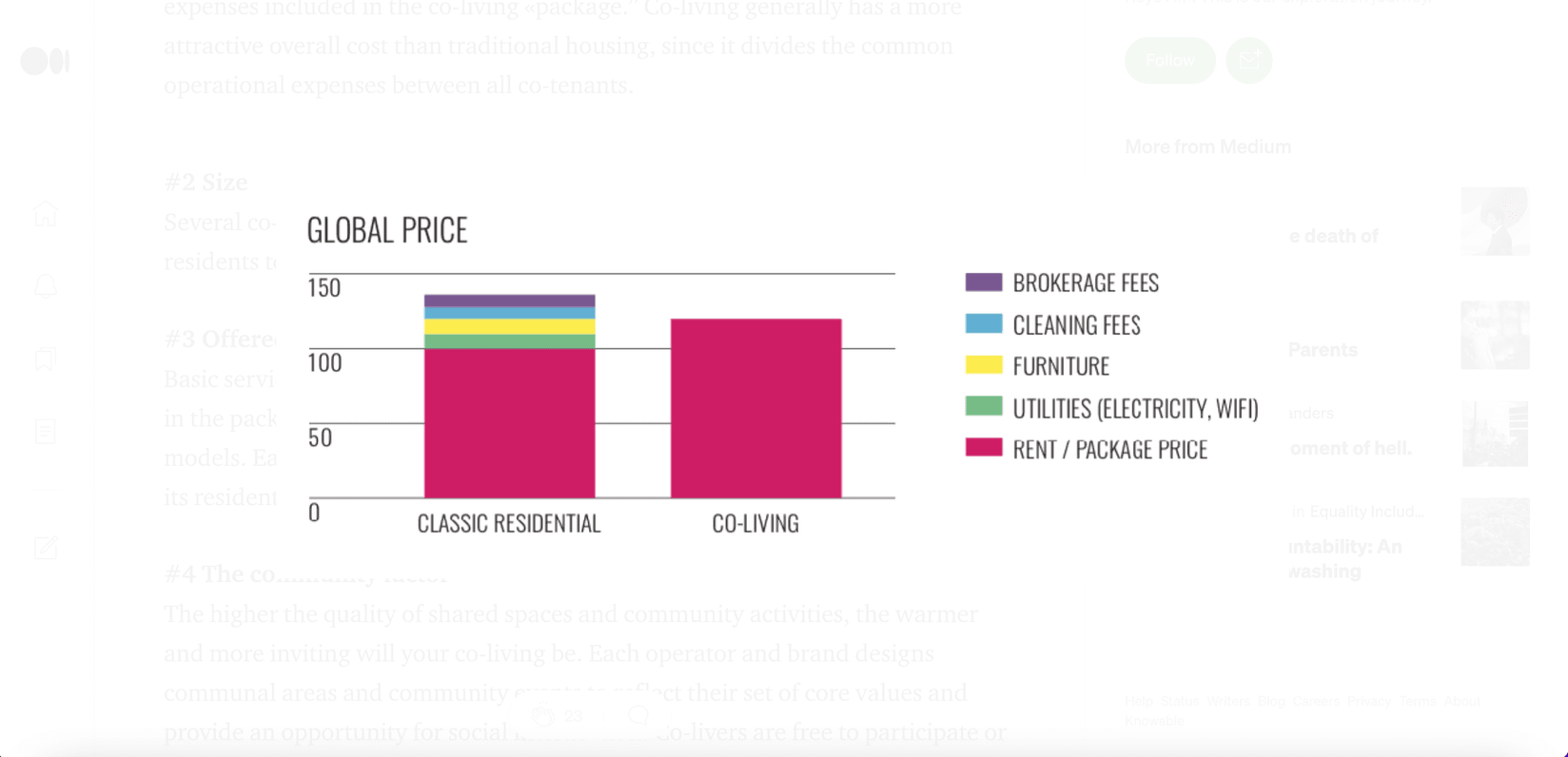- Features
- Solutions
- Pricing
- Resources
- Contact
- Book a demo

Table of Contents
- What Is Coliving?
- What Are the Differences Between Coliving and Coworking?
- Why Do People Believe Coliving Is the New Coworking?
- The History and Conception of Coliving
- Who Are Coliving Spaces Designed for?
- How Can Your Coliving Space Help Entrepreneurs Develop Their Brand or Business?
- What Are the Other Benefits Your Coliving Space Offers?
- Are There Any Drawbacks to Coliving?
- Tips for Transitioning into Coliving Spaces
- How Does Coliving Work for Remote Employees?
- Is Coliving the Future?
An innovative community-living model designed for peak performance and productivity, coliving provides accommodation for professionals across various industries. With no property taxes, homeowners' association fees, or maintenance costs, workers can live in a well-maintained shared home with a safe, modern, and professional environment.
Coliving enables workers to live the life of their dreams by removing outside distractions that might derail goals of maximum productivity and personal growth—especially if they have a full-time job in a high-pressure, competitive industry.
By allowing individuals to focus on their business or professional career entirely, you can completely immerse them in the professional experience that is co-working and co-living.
What Is Coliving?
A more modern approach to cultivating a professional lifestyle, coliving enables members to live in independently-owned apartments or shared homes while pursuing a more sustainable lifestyle. Think of a shared workspace in a coffee shop setting where like-minded individuals live and work together, usually on a month-to-month basis.
All they need is the internet, a good work ethic, the best enterprise phone system, and access to the community’s resources somewhere in a chic home or apartment where they can enjoy the comforts of a freshly cooked meal and hot shower as well. Self-storage is always an option for those who find it difficult to adjust to coliving space-wise and need some extra space for their belongings.
What Are the Differences Between Coliving and Coworking?
The two are not that different, with both being based on the same idea of distributed collaborative working. Both coliving and coworking aim to eliminate the need for the same space, technology, and administrative services and make it possible to share a similar community of like-minded individuals with similar business models.
However, in contrast with coworking, coliving is focused on professionals residing in the same house as opposed to just working together. While coworking provides individuals with a shared office space, coliving offers an entire residence dedicated to nurturing an employee’s profes
Why Do People Believe Coliving Is the New Coworking?
The way we work and live is undergoing a dramatic shift, with more people opting to live alone or as part of a larger community rather than in a professional setting. And even more people than ever are opting to work remotely.
While coworking offers many of these amenities, it’s still considerably expensive and can sometimes be forced on professionals by economic circumstances. By comparison, coliving can offer a more affordable and sustainable alternative and allow workers to be close to a supportive community while having the flexibility to live where they want.
The coliving movement, however, has been met with hesitation by many. Some professionals believe it’s not conducive to the new business mindset, while others feel it may attract the wrong kind of tenants.
Regardless, the number of people working on a flexible schedule and living alone has only grown since coworking became more popular. Because of this, there has been a push for the development of software explicitly dedicated to remote work from home or shared working environments in the last few years.
The History and Conception of Coliving
The concept of coliving can be traced back to the early 1960s when artists and designers were frustrated with the traditional urban apartment living experience. They created modern living spaces in “communal flats,” which allowed artists and creative minds to live in affordable dwellings by offering all the perks of a communal space without the cost of maintenance and upkeep.

Once established, these flats-cum-collective lived experiences offered an eclectic mix of strangers who were able to connect with and support one another thanks to their unique circumstances. In many cases, these flats were used as free incubators for radical programs that sought to change society, promote inclusivity, and shift power dynamics, regardless of gender, race, sexual orientation, or national origin.
The influence of these communal living spaces and the idea of coliving continued into the ‘80s, with loft living and coliving spaces becoming increasingly popular. Coliving spaces are a turn of the millennium reincarnation of the 1960s flats, resulting from the success of various coliving spaces throughout the 2000s to 2022 and beyond.
Due to the growing economic concern, shifting social attitudes on collaboration, and community-centered activities, coliving has become a popular trend among people seeking more sustainable and affordable employment options.
Streamlining and optimizing every aspect of our professional lives has allowed businesses to focus more on what really matters—for example, the introduction of virtual offices, tools such as customer relationships and retail inventory management systems, and the implementation of artificial intelligence.
Who Are Coliving Spaces Designed for?
Professionals who join coliving communities come from various cultural, socio-economical, and political backgrounds and work to promote acceptance and growth. The inclusivity of coliving is perfect for people of all backgrounds to come together to collaborate and explore their creativity. This is something to highlight when advertising your coliving space.
Coliving communities tend to be at the forefront of technology, networking, and social change, and so the groups you’re typically aiming at will be the young, aspiring millennial generation who want to work on socially responsible and more innovative projects—but cannot afford to live in an urban setting.
For these reasons, coliving communities need to be extremely community-focused and are often staffed by young and socially-driven millennials aged between 20 and 25. This community-focused approach is essential because young millennials are not the ‘recreational’ buyers who often dominate the housing market.
Instead, they are ambitious, often economically-driven individuals who want to build a professional and collaborative community to further their careers and network.

So Is Coliving Only for Millennials?
Absolutely not; employee exit interviews have shown a clear demand for coliving across various age groups. Coliving spaces are for anyone who wants to share the beauty and challenges of communal living spaces with like-minded individuals. In fact, they’re designed to be inclusive of all ages and walks of life.
So whilst it may be tempting to only focus on attracting millennials to your coliving space, don’t rule out other individuals who are looking for this unique working environment.
Generate recurring revenue and offer exceptional customer experience at your shared or coworking space
How Can Your Coliving Space Help Entrepreneurs Develop Their Brand or Business?
By expanding their network with like-minded individuals who have the same career goals or values as them, it’s more likely they’ll be successful. In some instances, they may even be able to make a good chunk of money running a freelance business from home.
In addition, you provide entrepreneurs with a home base to access their day-to-day tools or create their next great idea in a calm, relaxed environment. With local phone numbers at their fingertips and a dedicated environment to focus on making calls, sales, and connections - their performance is bound to skyrocket.
What Are the Other Benefits Your Coliving Space Offers?
There are also various other benefits to coliving, including everything from professional development to spacious locations.
Spacious Locations
Similar to the advantages of coworking, coliving is ideal for those who are constantly on the move. A combination between community and cohousing, coliving communities are often private homes subdivided into private living rooms, work areas, kitchens, and even a media room.
With its individual focus and autonomy, your coliving space will foster inclusivity, building community and supporting a sense of belonging and connection between residents.
Provides Opportunities to Move
Beneficial for anyone interested in making a move towards a more comfortable living situation with like-minded professionals, it’s also perfect for younger entrepreneurs looking to venture away from home.
Development
Living with inspiring and experienced professionals is bound to do wonders for your resident entrepreneur’s motivation and productivity - not to mention there’ll always be someone to bounce ideas off. Coworkers can learn new skills from their colleagues and share talents of their own, exchange performance marketing strategies, or get feedback from their colleagues. It’ll also help them develop professional networks, which should help them bring in more clients and have a more extensive range of resources to draw from.
Cost-effective
As bills are often included in the membership price, colivers can manage their expenses from a single location which means they don’t have to find a roommate to split the rent. Additionally, costs are generally minimal because everyone shares common areas such as living rooms, kitchens, and even cleaning services.
If you’re not including bills in your membership costs consider doing so as a way to make your space more attractive.
Flexibility
Coliving communities typically have flexible rules and regulations that will allow members to live their life in the best way for them. Make sure your coliving space is sensitive to this and provides the flexibility workers need.
Low-Stress
You can help minimize the stress of your members by including services such as cleaning and a remote office phone service. By taking away the pressure of many household chores and allowing for high-quality communication, workers will have the ability to scale their company effectively and with minimal stress. Take additional precautions to also ensure that the space is also safe and secure so workers can fully relax and focus on their work.
Are There Any Drawbacks to Coliving?

The growth of coliving highlights the potentially exciting new dynamics associated with multi-generational living situations and points to the stresses and challenges to come. Because coliving involves joining with people you wouldn’t ordinarily associate with, sometimes the constraints and expectations from one’s housemates can affect interpersonal relationships.
Coliving communities typically involve people from different cities and backgrounds, so the need to adapt to new personalities, cultures, and mindsets may be complex for some individuals. As a coliving manager it’s your job to be aware of this and to do your best to help residents feel comfortable and at home.
Tips for Transitioning into Coliving Spaces
Making this transition is not without its challenges, however, so here are some tips for how to make your transition into managing a coliving community a successful one:
- Take a look at the professionals and employers in your area and compare what they offer regarding professional facilities. This will give you a better understanding of what services to offer to your residents.
- Coliving communities tend to be highly focused on providing people with access to what they need and should be something you’re interested in facilitating. This could include everything from tech support to organizing social events.
- Find a great match of the right people that enjoy the same things and share values and vision. This will help workers integrate more easily and help you build a strong community.
How Does Coliving Work for Remote Employees?
In 2020, international companies started allowing their staff members to work at home to ensure business as usual and found a significant improvement in employee work ethic. We can deduce the implication that coworking and the flexibility to work from anywhere considerably boost productivity and professional drive.
According to research, 76% of employees say they prefer to work remotely, and 48% of those surveyed also feel it improves their ability to deliver top-notch customer service. Because of this, global companies are starting to take their employees and customers to virtual offices.
Living, learning, and working together develop shared knowledge and experiences that help people grow and evolve. It creates opportunities to work and learn together while also connecting with similar mindsets and principles that spur innovation.
In light of the move towards virtual workspaces, fully integrated communications systems have maximized the use of VoIP to provide features like video conferencing, one-click phone and screen sharing, and instant messaging. These services are accessible across the entire organization, but more importantly, everyone has an equal opportunity to participate in the digital dialogue–even AIs such as Dialpad’s chatbot.
Is Coliving the Future?
Similar to home shares but much more exclusive and even nicer, coliving communities offer an ideal alternative to coworking spaces. Currently boasting over 30 thousand members from several continents, the coliving network has continued to grow rapidly over the last few years.
With members across the globe and many established companies and organizations like HubSpot, Uber, and The University of Amsterdam’s Creative Futures program, coliving communities are shaping up to be a powerful force in our workspaces.
Your coliving space can provide an environment that helps remote workers create and grow their brand, build something lucrative, or launch their next entrepreneurial venture.
The article was written by Jessica Day, the Senior Director for Marketing Strategy at Dialpad, a modern business communications platform, Dialpad PBX takes every kind of conversation to the next level—turning conversations into opportunities. Jessica is an expert in collaborating with multifunctional teams to execute and optimize marketing efforts, for both company and client campaigns. Here is her LinkedIn. Jessica has also written content for PayTabs and Omnify.




